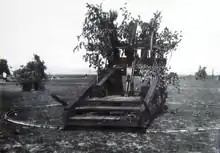Ștefan Burileanu
Ștefan Burileanu (10 January 1874–1951) was a Romanian officer, engineer, inventor, and academic who rose to the rank of major general in 1933.[1]

Burileanu was born in Burila Mică village, Mehedinți County. He went to high school in Paris, graduating in 1891. From 1892 to 1894 he studied engineering and military science at École Polytechnique and from 1894–1896 at the Saint-Cyr military school in Fontainebleau. He completes his studies in France in 1901, earning a Ph.D. degree from the Sorbonne with a thesis titled Nouvelle méthode de balistique extérieure.[2]
In 1915 he designed and built a 57mm anti-aircraft cannon which he named Burileanu. The cannon was widely used by the Romanian Army in World War I,[1] bringing down German planes at Mărășești, Piatra Neamț, and Bârlad. He also contributed to the Romanian victory at the Battle of Mărășești through the modifications he made to its cannons and howitzers.[3]
Between 1923 and 1930 Burileanu was a professor of mechanics at the University of Cluj. He was elected titular member of the Romanian Academy of Sciences (Military Section) on 21 December 1935.[4]
Nowadays Burileanu is viewed as the father of the Romanian anti-aircraft artillery. In his memory, the Academy of Sciences has instituted a prize in his name.[3] A street in Bucharest also bears his name.
References
- Din elita artileriei, col. prof. univ. dr. Adrian STROEA, col.(r) Marin GHINOIU, București: Editura Centrului Tehnic-Editorial al Armatei, 2012, p. 58-59, ISBN 978-606-524-122-0
- Lista membrilor Academiei de Științe din România (ASR) (1936-1948) p.9
- Iorga, Ana (19 December 2018). "Ștefan Burileanu" (in Romanian). Retrieved 25 April 2020.
- List of Members of the Romanian Academy of Sciences in 1943 at the Wayback Machine (archived March 6, 2014)